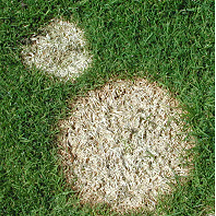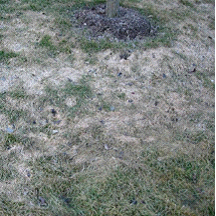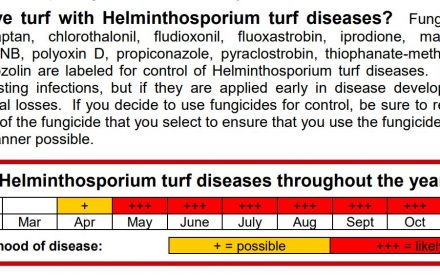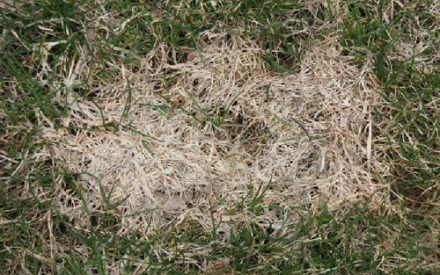
Sarah Rosenthal*, UW-Plant Breeding and Plant Genetics and Geunhwa Jung, formerly of UW-Plant Pathology
Revised: 5/11/2010
Item number: XHT1145
What is Microdochium patch? Microdochium patch, also known as pink snow mold, is a fungal disease affecting cool season grasses such as annual, Kentucky, and rough bluegrass; colonial, velvet, and creeping bentgrass; perennial ryegrass; and fine and tall fescue. These grasses are used in the majority of home lawns and golf courses in the Midwest.
What does Microdochium patch look like? Microdochium patch is characterized by the formation of circular patches of dead turf. The dead areas can range in size from a few inches to a few feet in diameter. When Microdochium patch develops on short-cut turf under a layer of snow, distinct dead patches appear that are bleached and matted. When the disease develops on short-cut turf in the absence of snow, dead patches appear reddish-brown. White fungal threads (called a mycelium) typically develop in the center of the patches, with pinkish-red threads forming at the borders. On taller grass (greater than six inches), yellow blighted patches with diffuse margins can form.
Where does Microdochium patch come from? Microdochium patch is caused by the fungus Microdochium nivale which survives as fungal threads or spores in infested plant debris. The fungus begins to grow under the snow during the winter and continues to grow until the turf warms and dries in the spring. In addition, Microdochium patch can be found during damp, cool spring and fall weather. The disease is more severe under cool (30 to 60°F), wet conditions, in alkaline soils, and when high levels of nitrogen fertilizer are applied early (or extremely late) in the growing season.
How do I save turf with Microdochium patch? Turf with Microdochium patch will often recover, but severely affected areas will need to be reseeded or replaced with Microdochium patch-resistant turf. The least susceptible grass species are Kentucky bluegrass and fine fescue.
How do I avoid problems with Microdochium patch in the future? When establishing a lawn, make sure that soils are well-drained and do not accumulate excessive amounts of water. Make sure that the soil pH is 7.0 or below, and also be sure to plant a Microdocium patch resistant grass variety (e.g., Kentucky bluegrass or fine fescue). In established lawns, DO NOT apply fast releasing nitrogen fertilizers (e.g., urea or ammonium nitrate) in the fall, and continue to mow grass until it goes dormant. Maintain a soil pH of 7.0 or below. Remove thatch in your lawn in either September or May, if the thatch layer is greater than 1/2 inch. Building a snow fence to minimize snow accumulation, and encourage rapid snow melting may also help reduce the incidence and severity of Microdochium patch. Fungicides containing the active ingredients azoxystrobin, chlorothalonil, fenarimol, fludioxonil, iprodione, mancozeb, myclobutanil, PCNB, polyoxin D, propiconazole, pyraclostrobin, thiophanate-methyl, thiram, triadimefon, trifloxystrobin, and vinclozolin are labeled for Microdochium patch control, and can be applied in October or November to prevent disease in the spring. However, these treatments are often not cost-effective. If you decide to use fungicides for control, be sure to read and follow all label instructions of the fungicide that you select to ensure that you use the fungicide in the safest and most effective manner possible.
Additional Images
Download Article






 Red Thread
Red Thread Helminthosporium Turf Diseases
Helminthosporium Turf Diseases Fairy Rings
Fairy Rings Lawn Disease Quick Reference
Lawn Disease Quick Reference


